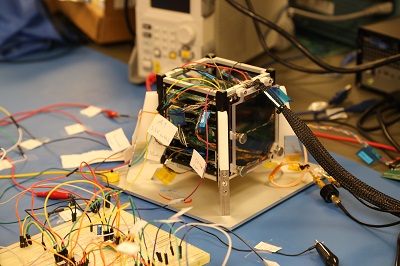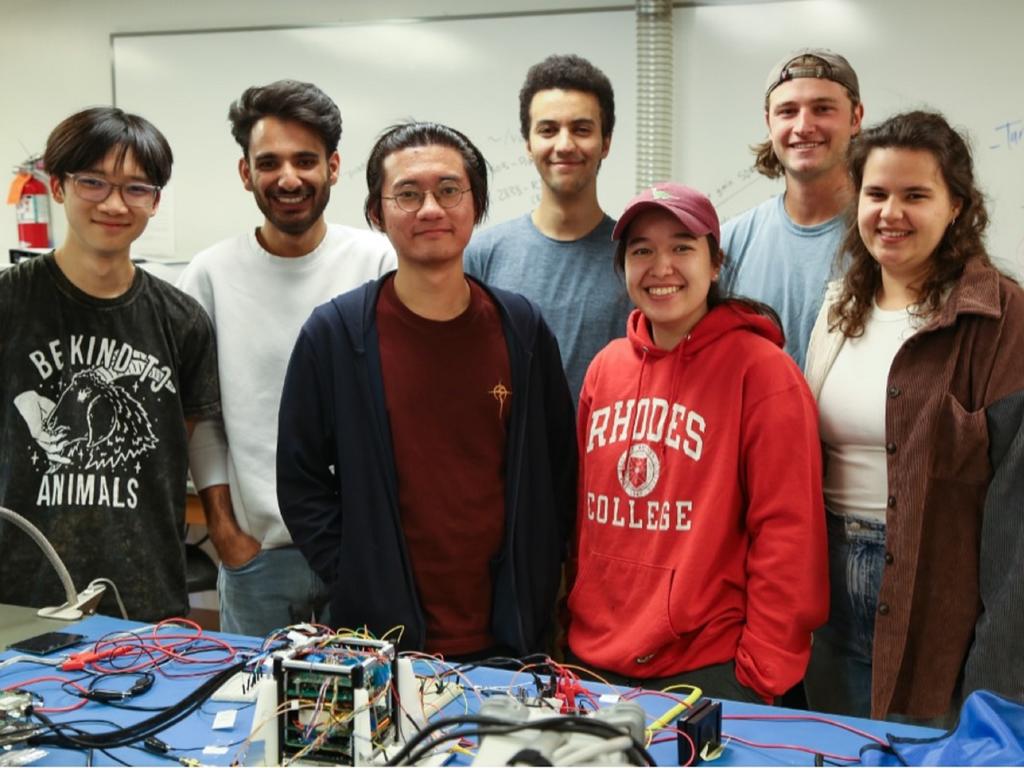In the spring of 2021, a Rhodes College team made up of faculty and students from various majors learned that a proposal for a four-inch cube satellite of their own design, named RHOK-SAT, was accepted by NASA’s CubeSat Launch Initiative. This program provides U.S. universities, high schools, and nonprofit organizations the opportunity to fly their miniature satellites aboard a NASA-sponsored rocket.
Now the team is working to have RHOK-SAT ready for launch into space by late 2024, and they have been practicing how they will communicate with it by tracking current satellites in space with a ground station built on campus.
Profs. Ann Viano, Brent Hoffmeister, Bentley Burnham, and instructional support technician Lanre Obadina of the Department of Physics and Prof. Phil Kirlin of the Department of Mathematics and Computer Science have served as the project’s faculty advisors. Alumnus Jose Pastrana ’20 is leading the software team in the production of the flight software and alumnus Brad Hensley ’12 is serving as a consultant for the project at large.
RHOK-SAT’s experiment is to investigate the hardiness and performance of new solar cell materials that may someday power spacecraft in orbits far from the Sun. These new solar cells are being investigated by The University of Oklahoma—ergo, the name RHOK-SAT, demonstrating the collaboration between Rhodes and Oklahoma. The team will be exploring how the cells hold up under solar radiation and the overall environment of space and if this type of cell material shows promise for future lunar and planetary missions.
According to Viano, these perovskite solar cells are layered thin-film materials with chemical compositions and atomic structures in the layers that lead to high output power when in sunlight. The name perovskite refers to the specific crystal structure in these thin-film layers. In recent years, these materials have increased in solar efficiency from 3 percent to almost 25 percent, and they represent a very promising solar cell material for long-range space missions.

RHOK-SAT will be in orbit for roughly one year and will transmit data to the Rhodes ground station on campus, where the Rhodes team has been retrieving data from satellites passing over the Memphis area. This ground station uses a large moveable antenna atop Rhodes Tower to track satellites and will send and receive information to and from RHOK-SAT. This station will be used by students to send commands to RHOK-SAT and download experimental data when it passes over Memphis.
Rhodes also is part of SatNOGS, an open-source ground-station network, in which users around the globe can receive satellite health data (e.g.battery status) from other satellites using another antenna atop Rhodes tower. The SatNOGS station at Rhodes includes an antenna, software-defined radio, a Raspberry Pi microcontroller board, and software from SatNOGS. The Rhodes ground station includes a large moveable antenna, a transceiver, and a computer interface that automates the tracking of satellites. While in orbit, RHOK-SAT will be performing tests of the perovskite cells’ power capacity and storing this data in the on-board computer until the data is downlinked to the ground station on campus.
“Our SatNOGS station installation was completed in summer 2022, and is now being used regularly by users all over the globe to catch and decode signals from all kinds of satellites, from other CubeSats to NOAA satellites, and even the International Space Station,” says Viano. “Having a working SatNOGS station at Rhodes allows us to now use SatNOGS stations anywhere in the world to listen for RHOK-SAT’s signals once it is in orbit. SatNOGS is only for listening to satellites, however. Our Rhodes ground station, with its large moveable antenna, is operating and has successfully sent and received signals from passing satellites. Its high-power transmitter will allow us to send commands and updated software to RHOK-SAT.”
The project began in 2019 after alumnus Dr. Charles Robertson Jr. ’65 encouraged Rhodes to develop a proposal to be submitted to NASA’s CubeSat Launch Initiative and generously provided funding for the project. The idea to test the space hardiness of novel solar cells for lunar and planetary missions came from students. Students have also been involved in writing software to collect and store data from RHOK-SAT and for the satellite to monitor the charge of its own battery and have designed and built the experimental hardware.
RHOK-SAT will disintegrate upon re-entry into Earth’s atmosphere, but hopefully it will have provided enough data to benefit future space missions.
